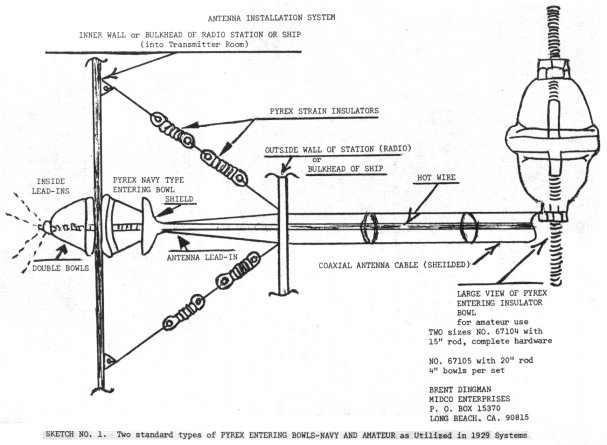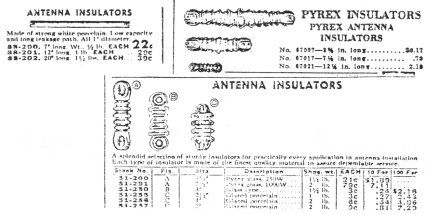Corning Pyrex Radio Insulator
by Brent Dingman
Reprinted from "INSULATORS - Crown Jewels of the Wire", July 1973, page 3
TECHNICAL HISTORICAL, AIR, LAND, AND SEA EXPEDITION INFORMATION
My experience indicates very few people collect or are familiar with radio
insulators. Like Lightning Balls and Vanes, more people are inquiring,
collecting; therefore I share the following information:
Many thanks to Mr. Walter E. Lehnert of 5209 Minnehaha Boulevard,
Minneapolis, Minnesota 55424 for providing me with the information from original
QST Amateur's or Ham's magazine issue November 1928 p7l, December 1929 p96,
September 1930 p67, February 1930 p69, and May 1931 p96. This information is
needed by all who want or have a collection lying around of these large and
small radio insulators as shown per sketch 1. They were first illustrated on
page 9, 10, and 11 of Insulator Magazine November 1972 issue.
Corning Glass Works Dept. 64 Industrial and Laboratory Divisions, Corning,
New York published a booklet in 1928 titled PYREX RADIO INSULATORS. As quoted,
"Over 300 broadcasting stations, leading radio telegraph systems, the
United States Army, Navy, Air Mail, Coast Guard, and Ice Patrol Services,
Explorers like Commander Byrd, and Amateurs everywhere have utilized PYREX
insulators in many spectacular achievements." "Regardless of whether
you are sending or receiving--on Land, Sea, or Airplane, you should be
thoroughly familiar with the Pyrex Antenna, Strain, Entering, Standoff and
Busbar insulators that are helping make these leaders radio history."
Technical information researched and quoted from the Pyrex ads, QST magazine
1928 and 1929 as follows: "Semi-tropical rains and moist salty atmosphere
do not impair the protection because PYREX insulators have a dense impervious
surface that sheds water and collects no deposits." "Likewise in dust
and smoke-laden atmosphere, particles that settle on PYREX insulators are blown
off by wind and washed off by rain, in any location there is no deterioration in
insulating value."
"The mechanical strength of PYREX insulators is equally permanent, so
that once they are placed they assure continuous operation." "In a
number of instances, storms that wreck wiring and towers did not break the Pyrex
insulators." "Their exceptionally low coefficient of expansion makes
them indifferent to sudden temperature changes." "Their dielectric
strength is from 15% to 35% greater than Porcelain." "Their power lost
is lower than any substance except pure fuzed quartz."
The Pyrex insulators illustrated per sketch 1 and page 10 of Insulator
magazine November issue 1972 were used in the radio room of the ship and antenna
system of "CITY OF NEW YORK" during the FIRST 1928 ANTARCTIC EXPEDITION
led by Commander Byrd. They were also used on his first PRE-TRANS-ATLANTIC
FLIGHT by air over the same pole. Mr. M. P. Hanson, Byrd's Chief Engineer,
writes as quoted, "We have every confidence that your product will render
good service under extreme conditions to be met, as they have done in the
past." THE REST IS HISTORY*****

Image text:
ANTENNA INSTALLATION SYSTEM
INNER WALL or BULKHEAD OF RADIO STATION OR SHIP (into Transmitter Room)
PYREX STRAIN INSULATORS
OUTSIDE WALL OF STATION (RADIO)
BULKHEAD OF SHIP
HOT WIRE
INSIDE LEAD-INS
ANTENNA LEAD-IN
PYREX NAVY TYPE ENTERING BOWL SHIELD
DOUBLE BOWLS
COAXIAL ANTENNA CABLE (SHIELDED)
LARGE VIEW OF PYREX ENTERING INSULATOR BOWL
for amateur use TWO sizes NO.
67104 with 15" rod, complete hardware
NO. 67105 with 20" rod
4" bowls par set
BRENT DINGMAN
MIDCO ENTERPRISES
P. 0. BOX 15370
LONG BEACH, CA. 90815
SKETCH NO. 1. Two standard types of PYREX ENTERING BOWLS-NAVY AND AMATEUR as
Utilized in 1929 Systems
TYPES OF PYREX RADIO INSULATORS SOLD IN LATE 20's, Reprinted from Radio
Magazine, Original Prices
 . .
The long white porcelain antenna insulators Numbers 38-200 to 202 above are
used on the antenna tension lines in radio stations, on land or sea stations.
Each end has brass fixtures (NOT SHOWN) which enables insulator to be connected
in series or attached side by side with hooks. Any quantity of them can be used.
Sketch 2. Small Pyrex Radio Antenna Insulators
In 1929 Broadcasting Station WQAM, Miami, Florida used the Antenna
Installation system as illustrated in sketch 1 with the Pyrex Radio Entering
Bowls and Strain Type. The PYREX Navy Type Entering Bowl coupled direct to the
end of the antenna carries the lead-in squarely through the center of an opening
in the wall, and two PYREX Strain Insulators in series on each anchorage and
tension line keep the radio energy IN and the disturbing stray secondary
currents OUT of the antenna. The large view-type is used in radio stations also
by hams as illustrated in sketch 1. These bowls can be used as individual
insulators and placed not only on the wall, but the ceiling. Small Pyrex radio
antenna insulators were also used in these systems and are shown in sketch 2,
along with their original prices and numbers as taken from the 1920 radio
magazines. I'm quite sure most collectors have this type in their collection.
These insulators or ones similar are still made for present day radio antenna
systems, but mostly made of porcelain instead of glass.
| 